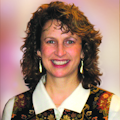CELL BIOLOGY/LIVE CELL IMAGING: Cell Bio extols optical methods
Visitors flying in to Philadelphia, PA for the 2014 American Society for Cell Biology Annual Meeting (December 6-10) began their cell-bio immersion at the airport, where a display called Larger Than Life treated travelers to large-scale cell images created by researchers from the Greater Philadelphia area.
This year's event represented a collaboration with the International Federation for Cell Biology (IFCB). The conference featured separate tracks for biophysics (which included a minisymposium on optical microscopy and super-resolution imaging) and medicine (which implicated optical techniques in the study of cell dysfunction, stem cells, and cancer, for instance, and also featured a translational session on bridging cell biology and medicine). ASCB 2014 president Jennifer Lippincott-Schwartz, Ph.D., of the National Institutes of Health—a well-known user of optical techniques—helped to keep the optics and photonics profile high. So did continued buzz about the 2014 Nobel Prize in Chemistry, which made the event as much a celebration as anything.
Exhibitors in the ASCB Learning Center (a.k.a. exhibit hall) showcased demonstrations of impressive tools for cutting-edge research. There were vendors of microscopy and flow cytometry instruments that rely on optics. For instance, Nikon Instruments introduced its Ti-diSPIM, which adds selective plane illumination ("light-sheet") to Nikon's Ti inverted research microscope. The result is cell imaging with minimal phototoxicity and photobleaching, in combination with such applications as fluorescence recovery after photobleaching (FRAP), photostimulation, point-scanning confocal, and total internal reflection fluorescence (TIRF).
Also exhibiting were developers of key optical and photonics-based components. Among these were optics supplier Chroma Technology; vendors of high-performance cameras and other tools such as Andor Technology, Hamamatsu, and Photometrics; and purveyors of precision positioning equipment such as ASI and Mad City Labs. New light delivery systems on display included Mightex's Polygon 400 with spatial/temporal/spectral/intensity control; PicoQuant's Solea supercontinuum source; RPMC's DPSS lasers and laser diode modules with power, wavelength, and pointing stability; and Sutter Instruments' new Lambda HPX-L5 high-output LED source. World Precision Instruments offered its Biofluorometer, an inexpensive tool that combines digital timing and LED sources and handles up to seven wavelengths.
It's always fun to see startup companies integrating optical methods into cutting-edge wares. Biomeme, a company local to the Philadelphia venue, demonstrated its smartphone-based real-time PCR solution with applications in point-of-need clinical diagnostics, biothreat detection, education, food safety, and more. Biomeme claims to provide rapid DNA detection accurate to current laboratory gold standards in a mobile system. And Nanolive promoted its new 3D Cell Explorer: a high-resolution, live-cell tomography system that measures differences in refractive index to enable fast, quantitative measurements without sample prep. Notwithstanding the impressive achievements of Betzig, Hell, and Moerner, the company hopes to take chemistry out of the equation for cell imaging.
The ASCB 2015 annual meeting will take place December 12-16 in San Diego, CA.
About the Author

Barbara Gefvert
Editor-in-Chief, BioOptics World (2008-2020)
Barbara G. Gefvert has been a science and technology editor and writer since 1987, and served as editor in chief on multiple publications, including Sensors magazine for nearly a decade.
